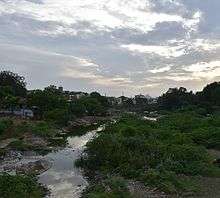Attur Fort
| Attur Fort | |
|---|---|
| Part of Tamil Nadu | |
| Attur, Tamil Nadu, India | |
|
Attur Fort | |
 Attur Fort | |
| Coordinates | 11°36′13″N 78°36′03″E / 11.603529°N 78.600868°E |
| Type | Forts |
| Site information | |
| Controlled by | Department of Archaeology |
| Site history | |
| Built | 17th century |
| Built by | Lakshmana Nayakan |
Attur Fort is a historic fort present in Attur in Salem district in the South Indian state of Tamil Nadu. The fort was built by a Palaiyakkarar chieftain under Madurai Nayaks, called Lakshmana Nayakan during the 17th Century. It was also occupied by Hyder Ali, Tipu Sultan and British during various times. The fort was used by the British as a garrison till 1854, after which the fort was not operational. In modern times, the fort is under the control of the Archaeological Department of the Government of Tamil Nadu. Some portions of the fort is dilapidated, while most other portions are enchorached by slum dwellers.
Location
Attur town is situated on the southern bank of the Vasista river. The town was called Attur Ananthagiri during the Mysore rule in 1689 and was called Attur by end of the 18th century. It was originally believed that the fort was built by the founder of the Catti Mudali dynasty, who built the Shiva and Vishnu temples in the fort.
History
Under Madurai Nayaks

Under Mysore Kingdom
The region became part of Mysore Wodeyar rulers and later under Hyder Ali of Mysore till 1768, when surrendered to Wood of East India Company. Hyder Ali regained the town from the British East India Company, but the Company won a decisive victory in the 3rd Mysore war was against Tipu Sultan, the son of Hyder Ali.
Under British
After the Third Mysore War the region became part of Madras Presidency under British.The fort was used by the British as a garrison from 1792 by and the 23rd Madras battalion under the command of captain compbell occupied it. During subsequent years, the fort was used as an ordinance station from 1799 as the Company troops moved to Sankagiri. After 1854, the fort ceased to act as an operational fortress and the region was clubbed into the newly formed Salem District under the Madras Presidency.


Recent status
In modern times, the fort is under the control of the Archaeological Department of the Government of Tamil Nadu. Some portions of the fort is dilapidated, while most other portions are enchorached by slum dwellers.[1][2][3] In modern times, the fort is maintained by the Archaeological Survey of India.[4]
Architecture

The fort occupies an area of 62 acres (250,000 m2) The walls of the fort are about 30 ft (9.1 m) tall and 15 ft (4.6 m) wide. It is decortated by wedge shaped cut-stones fitted without mortar. The construction material for the walls are believed to be quarried from the Kalladithankundru. The fort was guarded by the river in the east and by moats on other sides. Gatt dynasty used the large chamber inside the fort as audience hall during their regime. The pool house, used for the pleasure of the royal family, was fed from the river through a water gate.[1][5]
References
| Wikimedia Commons has media related to Attur Fort. |
- 1 2 "Attur Historical moments". Attur Municipality. 2011. Retrieved 2013-07-07.
- ↑ Great Trigonometrical Survey (1891). Synopsis of the Results of the Operations, Volume 25. Columbia University. p. 75.
- ↑ Fanu, Henry Le (1883). A manual of the Salem district in the presidency of Madras. Oxford University. p. 53.
- ↑ "Alphabetical List of Monuments - Tamil Nadu". Archaeological Survey of India. 2011. Retrieved 2013-09-09.
- ↑ "Historic fort". The Hindu. 14 January 2012. Retrieved 2013-07-07.